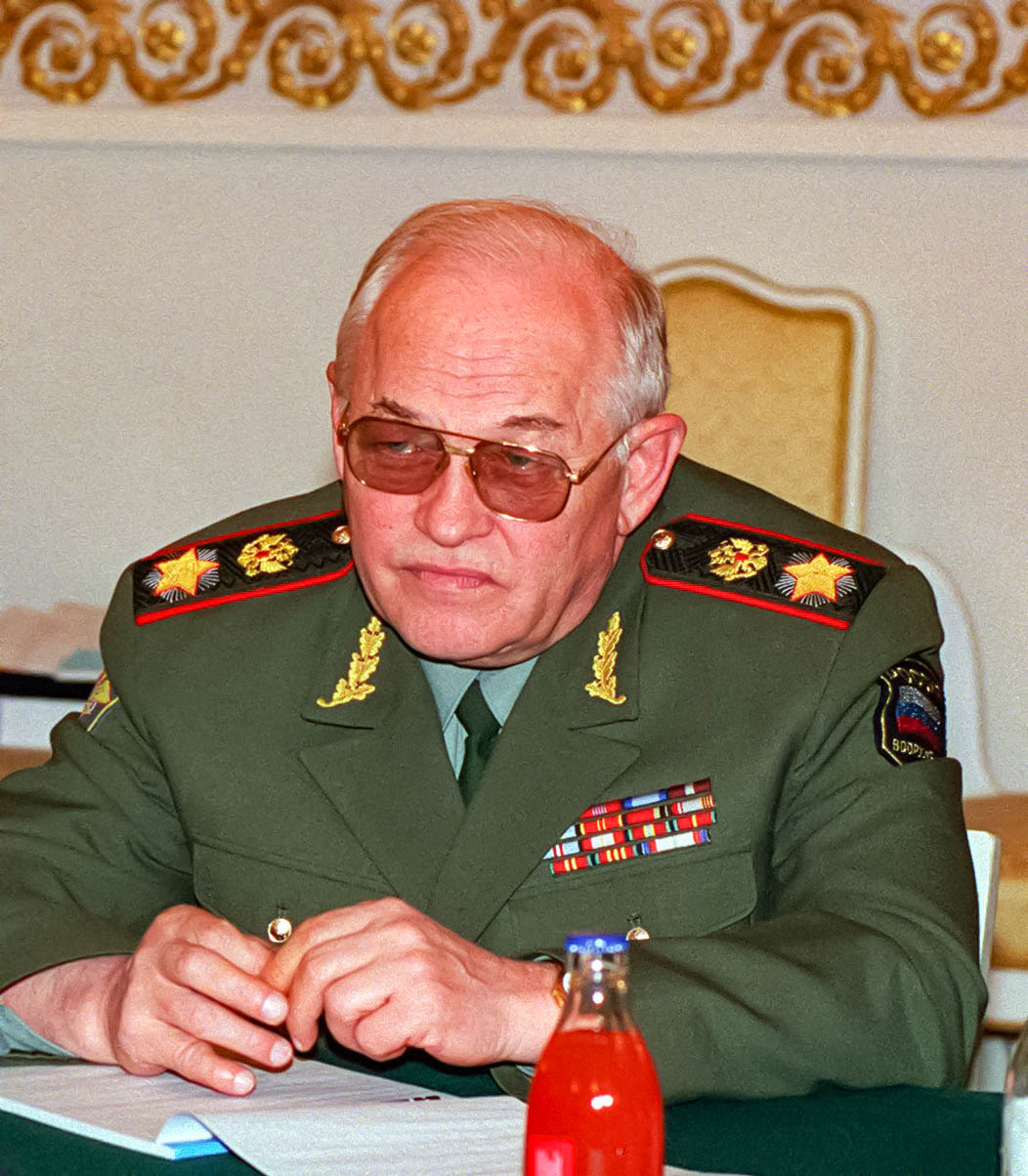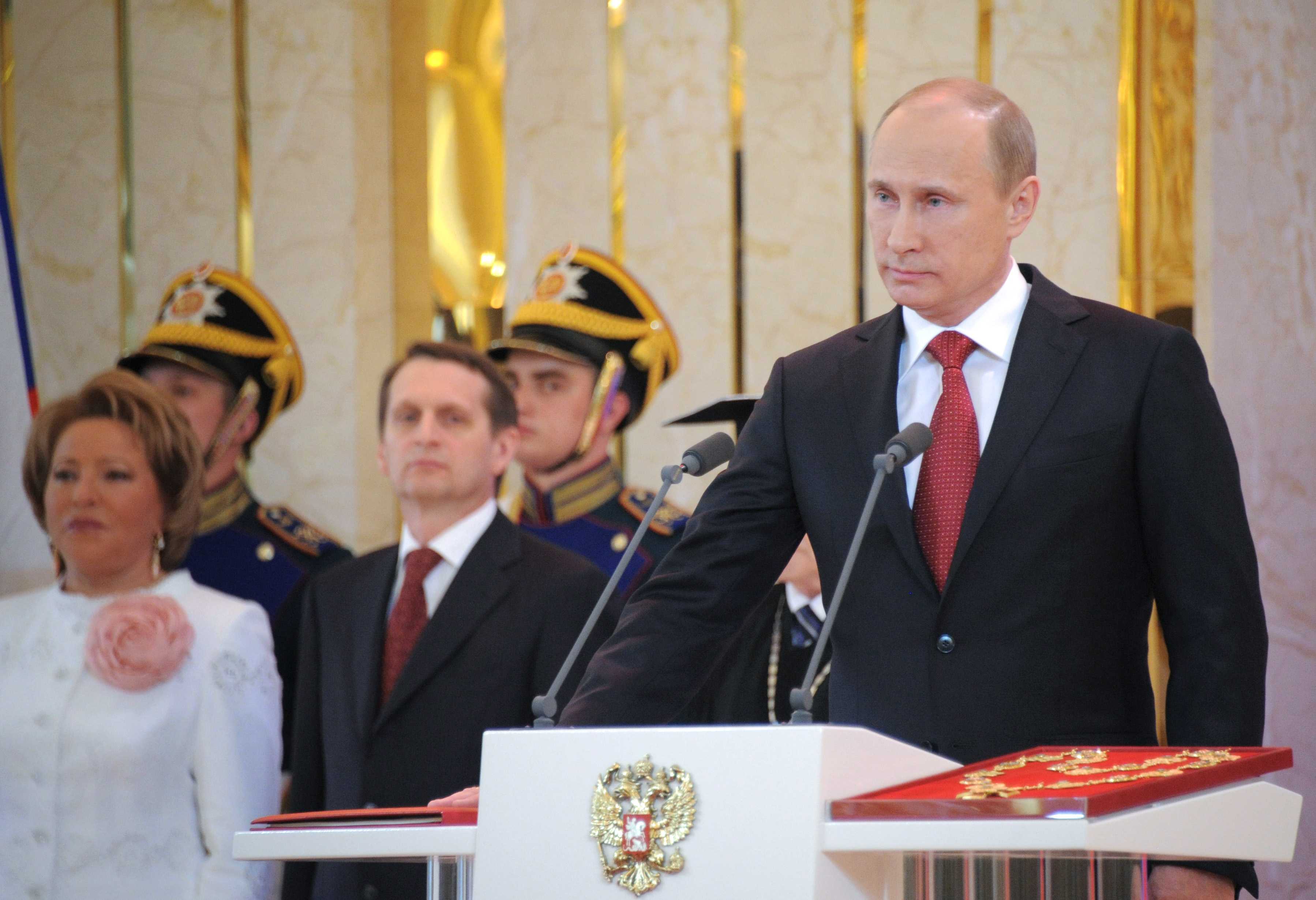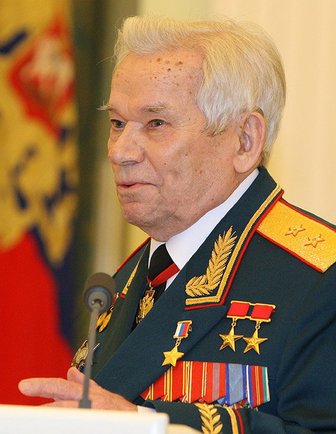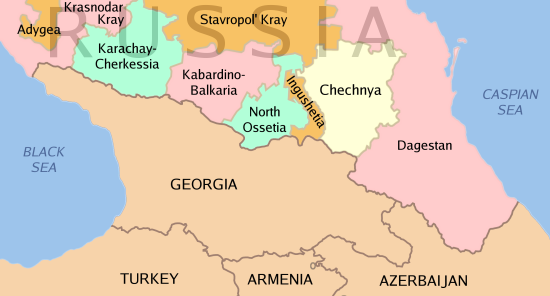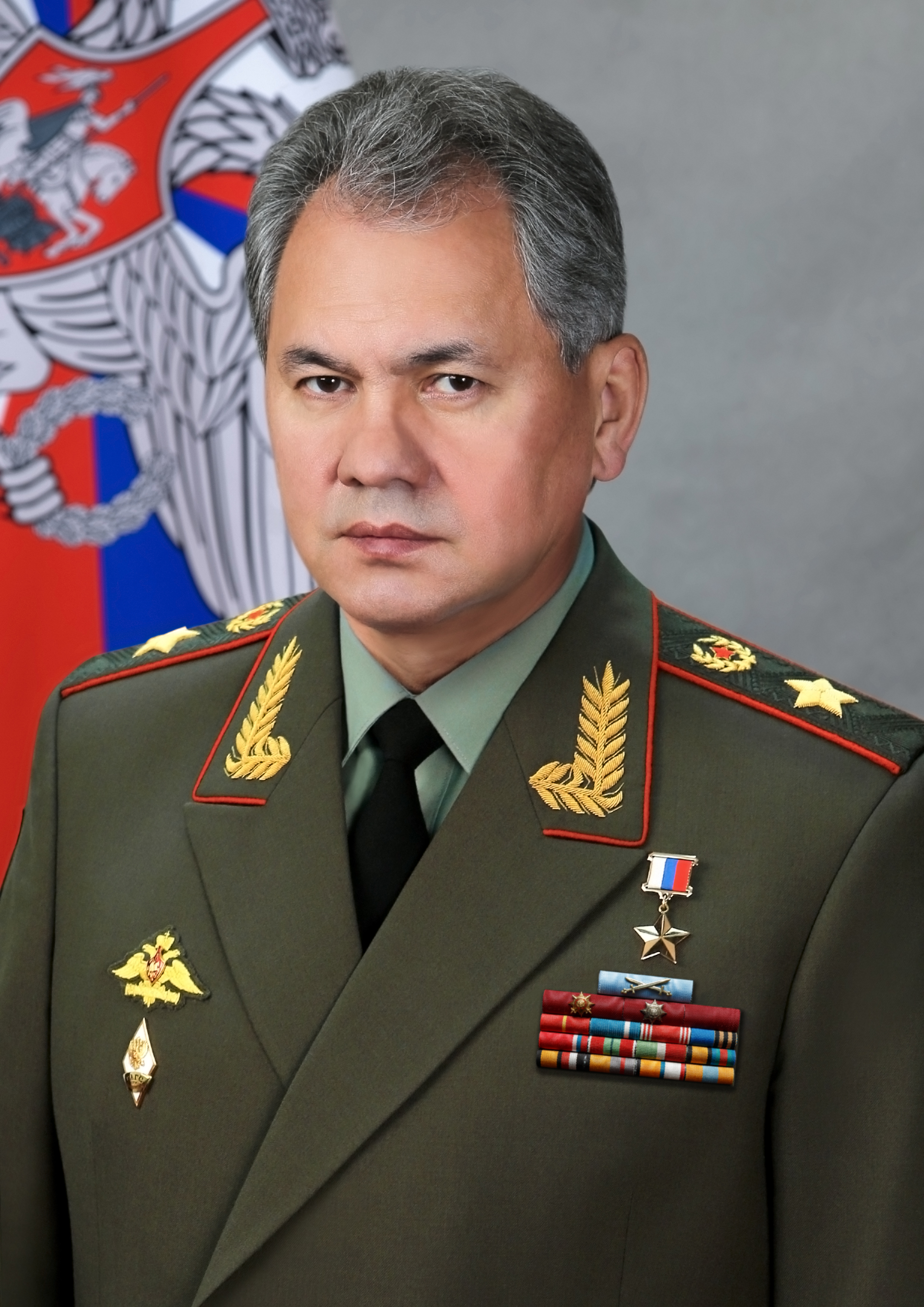|
Igor Sergeyev
Igor Dmitriyevich Sergeyev (; 20 April 1938 – 10 November 2006) was a Soviet and later Russian military officer who was Minister of Defense of Russia from 22 May 1997 to 28 March 2001. He was the first and, as of 2022, the only Marshal of the Russian Federation. Career Sergeyev served briefly in the Navy but later transferred to the Army, where he spent most of his career in the Strategic Rocket Forces. Sergeyev became commander in chief of the Strategic Rocket Forces in 1992. In this position he was in charge of securing the former USSR's nuclear weapons. Defense Minister Sergeyev was appointed Minister of Defense in 1997 by Russian President Boris Yeltsin. He was promoted to Marshal of the Russian Federation on 21 November 1997, the only Russian military officer to achieve that rank. Marshal Sergeyev accepted reform within a limited budget under civilian political control. The number of military educational establishments was reduced markedly from their previous levels, wh ... [...More Info...] [...Related Items...] OR: [Wikipedia] [Google] [Baidu] |
Marshal Of The Russian Federation
Marshal of the Russian Federation ( rus, Маршал Российской Федерации, r=Marshal Rossiyskoy Federatsii) is the highest military rank of Russia, created in 1993 following the dissolution of the Soviet Union. It ranks immediately above Army general and Admiral of the fleet (also called Fleet Admiral in some English-language texts), and is considered the successor to the Soviet-era rank of Marshal of the Soviet Union. A Marshal of the Russian Federation outranks Generals of the Army (four stars), Colonel-Generals (three stars), Lieutenant-Generals (two stars) and Major-Generals (one star). It is roughly equivalent to American General of the Army and the British Field Marshal. The only officer so far to have held the rank was Igor Sergeyev, the former Minister of Defence, who had been elevated from the General of the Army of the Strategic Rocket Forces. Sergeyev was a Marshal of the Russian Federation from 1997 until his death in 2006. The insignia for ... [...More Info...] [...Related Items...] OR: [Wikipedia] [Google] [Baidu] |
Russia
Russia (, , ), or the Russian Federation, is a List of transcontinental countries, transcontinental country spanning Eastern Europe and North Asia, Northern Asia. It is the List of countries and dependencies by area, largest country in the world, with its internationally recognised territory covering , and encompassing one-eighth of Earth's inhabitable landmass. Russia extends across Time in Russia, eleven time zones and shares Borders of Russia, land boundaries with fourteen countries, more than List of countries and territories by land borders, any other country but China. It is the List of countries and dependencies by population, world's ninth-most populous country and List of European countries by population, Europe's most populous country, with a population of 146 million people. The country's capital and List of cities and towns in Russia by population, largest city is Moscow, the List of European cities by population within city limits, largest city entirely within E ... [...More Info...] [...Related Items...] OR: [Wikipedia] [Google] [Baidu] |
Russian President
The president of the Russian Federation ( rus, Президент Российской Федерации, Prezident Rossiyskoy Federatsii) is the head of state of the Russian Federation. The president leads the executive branch of the federal government of Russia and is the commander-in-chief of the Russian Armed Forces. It is the highest office in Russia. The modern incarnation of the office emerged from the president of the Russian Soviet Federative Socialist Republic (RSFSR). In 1991, Boris Yeltsin was elected president of the RSFSR, becoming the first non Communist Party member to be elected into Soviet politics. He played a crucial role in the dissolution of the Soviet Union which saw the transformation of the RSFSR into the Russian Federation. Following a series of scandals and doubts about his leadership, violence erupted across Moscow in the 1993 Russian constitutional crisis. As a result, a new constitution was implemented and the 1993 Russian Constitution remains in ... [...More Info...] [...Related Items...] OR: [Wikipedia] [Google] [Baidu] |
Strategic Rocket Forces
The Strategic Rocket Forces of the Russian Federation or the Strategic Missile Forces of the Russian Federation (RVSN RF; russian: Ракетные войска стратегического назначения Российской Федерации (РВСН РФ), Raketnye voyska strategicheskogo naznacheniya Rossiyskoy Federatsii, lit. 'Strategic Purpose Rocketry Troops') are a separate-troops branch of the Russian Armed Forces that control Russia's land-based intercontinental ballistic missiles (ICBMs). The Strategic Rocket Forces was created on 17 December 1959 as part of the Soviet Armed Forces as the main force intended for attacking an enemy's offensive nuclear weapons, military facilities, and industrial infrastructure. They operated all Soviet nuclear ground-based intercontinental, intermediate-range ballistic missile, and medium-range ballistic missile with ranges over 1,000 kilometers. After the Soviet Union collapsed in 1991, assets of the Strategic Rock ... [...More Info...] [...Related Items...] OR: [Wikipedia] [Google] [Baidu] |
Soviet Army
uk, Радянська армія , image = File:Communist star with golden border and red rims.svg , alt = , caption = Emblem of the Soviet Army , start_date = 25 February 1946 , country = (1946–1991)' (1991–1992) , branch = , type = Army , role = Ground warfare, Land warfare , size = 3,668,075 active (1991) 4,129,506 reserve (1991) , command_structure = , garrison = , garrison_label = , nickname = "Red Army" , patron = , motto = ''За нашу Советскую Родину!(Za nashu Sovetskuyu Rodinu!)''"For our Soviet Motherland!" , colors = Red and yellow , colors_label = , march ... [...More Info...] [...Related Items...] OR: [Wikipedia] [Google] [Baidu] |
Defence Minister Of The Russian Federation
The Minister of Defence of the Russian Federation (russian: Министр обороны Российской Федерации) is the minister responsible for the Russian Armed Forces. Marshal of Aviation Yevgeny Shaposhnikov was the last Minister of Defence of the Soviet Union. General Colonel Konstantin Kobets supported then President of the Russian Soviet Federative Socialist Republic Boris Yeltsin during the August coup of 1991. From 19 August until 9 September 1991, Konstantin Kobets was Defense Minister of the RSFSR, though there was no ministry. This post was then abolished. The first Minister of Defence of the Russian Federation was Boris Yeltsin, who appointed himself to the position by a decree of mid March 1992. William Eldridge Odom, 'The Collapse of the Soviet Military,' Yale University Press, 1998, , p. 385. List of Ministers of Defence Former First Deputy Ministers of Defence * Andrei Kokoshin (3 April 1992 – 25 January 1996); (25 January 1996 – 28 ... [...More Info...] [...Related Items...] OR: [Wikipedia] [Google] [Baidu] |
Hero Of The Russian Federation
Hero of the Russian Federation (russian: Герой Российской Федерации, Geroy Rossiyskoy Federatsii), also unofficially Hero of Russia (russian: link=no, Герой России, Geroy Rossii), is the highest honorary title of the Russian Federation. The title comes with a Gold Star medal, an insignia of honour that identifies recipients. The title is awarded to persons for "service to the Russian state and nation, usually connected with a heroic feat of valour". The title is bestowed by decree of the president of the Russian Federation. Russian citizenship or being in the service of the Russian state is not obligatory. The title was established in 1992 and, , was awarded more than 970 times, of which more than 440 were posthumously. History The title "Hero of Russia" is a successor to Hero of the Soviet Union (russian: link=no, Герой Советского Союза), which was established by Resolution of the Central Executive Committee of the Sovi ... [...More Info...] [...Related Items...] OR: [Wikipedia] [Google] [Baidu] |
Second Chechen War
The Second Chechen War (russian: Втора́я чече́нская война́, ) took place in Chechnya and the border regions of the North Caucasus between the Russia, Russian Federation and the Chechen Republic of Ichkeria, from August 1999 to April 2009. In August 1999, Islamist fighters from Chechnya War of Dagestan, infiltrated Russia's Dagestan region, violating Russia's borders. During the initial campaign, Russians, Russian military and pro-Russian Chechens, Chechen paramilitary forces faced Chechen separatists in open combat and seized the Chechen capital Grozny after a winter Battle of Grozny (1999–2000), siege that lasted from December 1999 until February 2000. Russia established direct rule over Chechnya in May 2000 although Chechen militant Resistance movement, resistance throughout the North Caucasus region continued to inflict heavy Russian casualties and challenge Russian political control over Chechnya for several years. Both sides carried out attacks a ... [...More Info...] [...Related Items...] OR: [Wikipedia] [Google] [Baidu] |
War Of Dagestan
The Dagestan War (russian: Дагестанская война), also known as the Invasion of Militants in Dagestan (russian: Вторжение боевиков в Дагестан) began when the Chechnya-based Islamic International Peacekeeping Brigade (IIPB), an Islamist group, led by Shamil Basayev, Ibn al-Khattab, Ramzan Akhmadov and Arbi Barayev, invaded the neighboring Russian republic of Dagestan, on 7 August 1999, in support of the Shura of Dagestan separatist rebels. The war ended with a major victory for the Russian Federation and Dagestan Republic, and the retreat of the IIPB. The invasion of Dagestan served as the main casus belli alongside the series of apartment bombings in September 1999 for the Second Chechen War. Background During the inter-war period of 1996 to 1999, a war-ravaged Chechnya descended into chaos and economic collapse. Aslan Maskhadov's government was unable to rebuild the region or to prevent a number of warlords from taking effective co ... [...More Info...] [...Related Items...] OR: [Wikipedia] [Google] [Baidu] |
Ministry Of Defence (Russia)
The Ministry of Defence of the Russian Federation (russian: Министерство обороны Российской Федерации, Минобороны России, informally abbreviated as МО, МО РФ or Minoboron) is the governing body of the Russian Armed Forces. The President of Russia is the Commander-in-Chief of the Armed Forces of the Russian Federation and directs the activity of the Ministry. The Defence Minister exercises day-to-day administrative and operational authority over the armed forces. The General Staff executes the president's and the defence minister's instructions and orders. The main building of the ministry, built in the 1940s, is located on Arbatskaya Square, near Arbat Street. Other buildings of the ministry are located throughout the city of Moscow. The supreme body responsible for the Ministry's management and supervision of the Armed Forces is The National Defense Management Center (Национальный центр управ ... [...More Info...] [...Related Items...] OR: [Wikipedia] [Google] [Baidu] |
